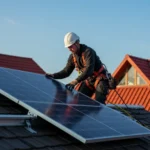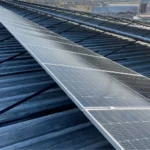How Azimuth Angle Impacts Solar Panel Efficiency for Homes, Industries, and Commercial Buildings
How Azimuth Angle Impacts Solar Panel Efficiency for Homes, Industries, and Commercial Buildings
Designing layout for a solar installation is an expert job and needs to be done with utmost care. There are two important considerations while designing solar panels installation , one is inclination of the panels and another is direction. The angle of tilt should be latitude of the place wherever the installation is being done to optimize the radiation of solar and direction should be true south.
While angle of tilt is easy to control ,the direction is not always possible to be maintained. If the building roof on which solar panels are to be installed is such that structure installation is not possible in true south direction then there is bound to be loss of generation. We have seen a lot of installations where because of paucity of space and ignorance of installer and client the solar plants are installed without giving a thought to tilt & direction and only aesthetic considerations are valued . This way though the client can be impressed but the very purpose of installing solar plant to generate rated power is compromised.
In case it is necessary then also the installer should try and reduce the impact of azimuth . To have a clear picture of loss of generation the following table may be used.
Suggested Articles

7 Common Myths about Solar Energy in India
Solar power is not only less expensive, but it is also the most abundant source of clean energy.

Solar Loans, Subsidies & EMI Plans: Financing Made Easy
Explore solar loans, government subsidies, and flexible EMI plans to make installing solar panels affordable and hassle-free.

Solar Power Set to Overtake Coal as World’s Largest Energy Source in Four Years
Solar power has come a long way in the past decade, moving from being an also-ran to one of the major players in the global energy race. According to the International Energy Agency, next year, solar photovoltaic capacity will surpass hydropower, followed by gas-fired generation in three years and coal in four years.

Rajasthan Rooftop Solar Subsidy: What Homeowners Need to Know
Rajasthan homeowners can save big with the 2025 rooftop solar subsidy. Learn about the updated rates, eligibility criteria, and benefits to make your switch to solar more affordable.

UPNEDA Solar Subsidy 2025: How to Maximize Savings on Rooftop Solar
Discover how the UPNEDA Solar Subsidy 2025 can help you cut electricity costs and make rooftop solar more affordable. Learn about eligibility, subsidy rates, and the step-by-step application process.

Fire Hazard in a Solar Setup at Rice Mill, Kaithal – Case Study and Safety Insights
A recent fire incident at a rice mill in Kaithal highlights the critical importance of safety in solar installations. This case study analyzes the root causes, system faults, and preventive actions that can help industries avoid similar hazards in their solar setups.

UP Discoms Propose 9.21% Electricity Tariff Hike for 2015-16
Uttar Pradesh Discoms propose a 9.21% increase in electricity tariffs for 2015-16, impacting residential, commercial, and industrial consumers across the state.

Solar Net Metering in Industrial Units: Opportunities and Risks
Solar net metering can help factories save on energy costs, but there are key pitfalls to consider. Learn the challenges and best practices for industrial adoption